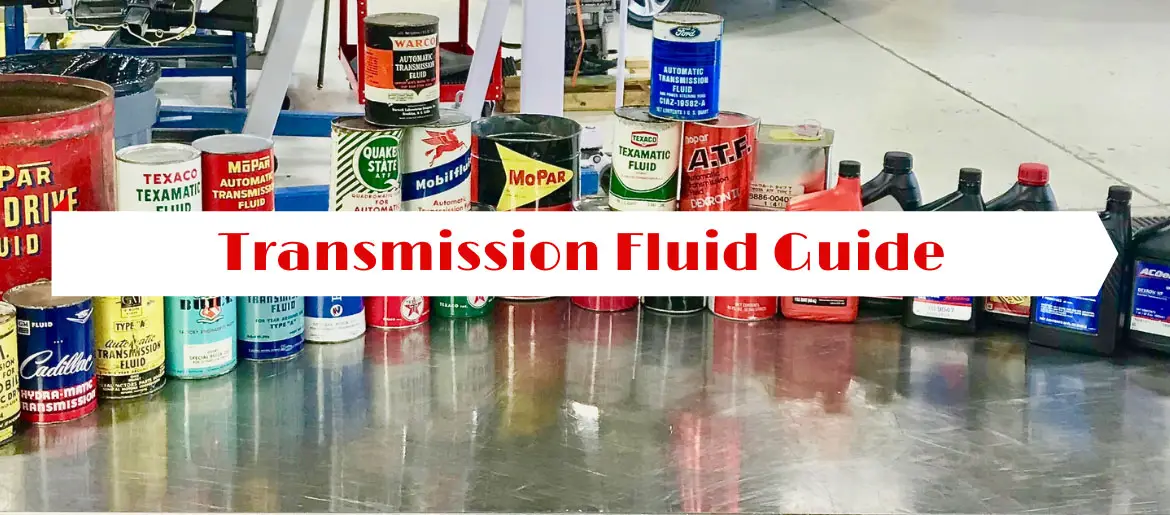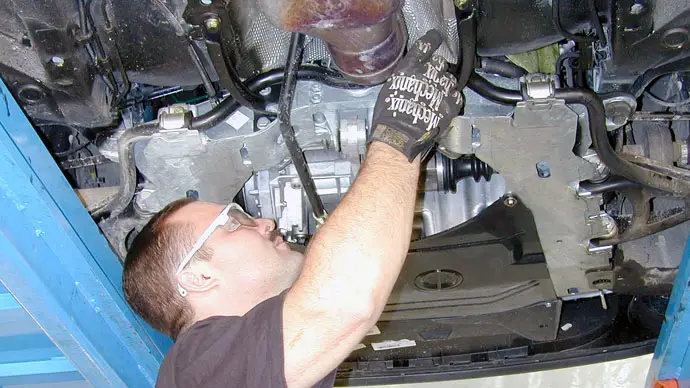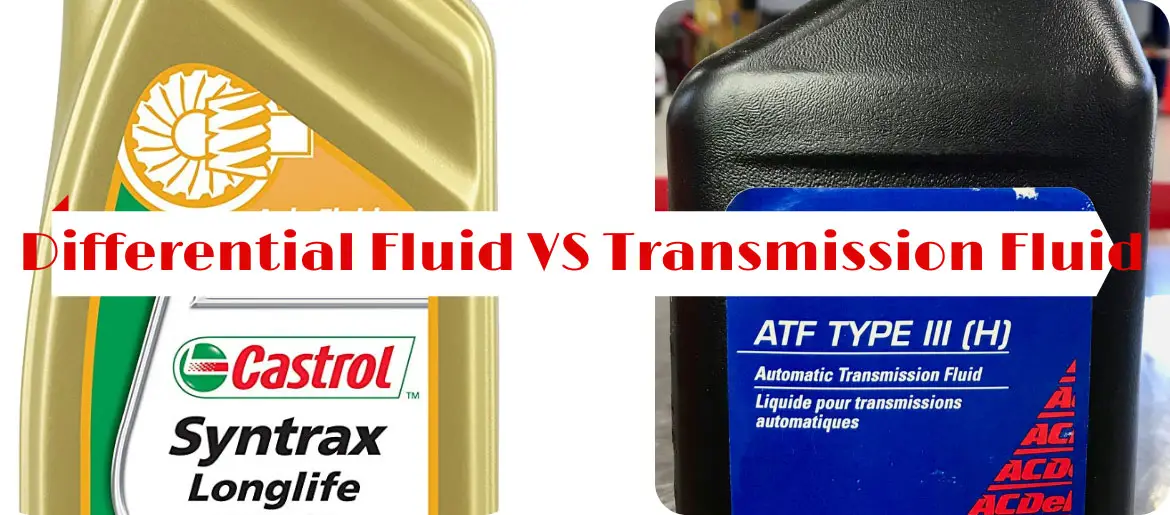Transmission Fluid Guide | 15 Most Asked Questions Answered!
Reviewed By: Joses Peter
As a car enthusiast, have you ever wished someone could inform your curious mind with all the information regarding transmission fluids?
It’s great to hear that you want to expand your knowledge on transmission fluids, which might be very useful at some point in your life. For example, if your friend is going to buy a new car, you can pass on your knowledge for clarification.
Or if you find your car’s transmission acting unusual all of a sudden, you’ll know what’s going on inside.

Since you’ve landed on this page, you don’t have to go anywhere because you’re exactly where you’re supposed to be! In order to enrich your curious mind with information, I have written this transmission fluid guide where you’ll find answers to the 15 most asked questions. Keep scrolling to find your answers!
- 1. What Is Transmission Fluid?
- 2. What Kind Of Transmission Fluid Do I Need?
- 3. What Does Transmission Fluid Smell Like?
- 4. How to Check Transmission Fluid?
- 5. How to Change Transmission Fluid?
- 7. How to Tell If Transmission Fluid Is Low?
- 9. How Long Does Transmission Fluid Last?
- 10. How Long Does It Take For Transmission Fluid To Circulate?
- 11. How to Dispose Of Transmission Fluid?
- 12. How to Remove Excess Transmission Fluid?
- 13. How to Read Transmission Fluid Dipstick?
- 14. Why Is My Transmission Fluid Coming Out My Vent Tube?
- 15. How Many Quarts in a Gallon of Transmission Fluid?
- Conclusion
- People Also Ask
1. What Is Transmission Fluid?
It’s never possible to drive a car without a transmission system. It is a part of the engine that transfers power from the engine to the drive wheels. While doing so, the transmission has to adjust the rotational speed of the engine so that the wheels can get the right amount of power needed for moving or coming to a halt.
And, none of that is even possible unless transmission fluid is added to the transmission system.
Transmission fluid is a fluid that lubricates the mechanical parts of the transmission and at the same time, acts as a hydraulic medium. Besides that, transmission fluid serves other purposes. They are as follows.
- Cleaning and protecting metal components against wear, rust, and corrosion.
- Conditioning the gasket
- Cooling the transmission
- Preventing the formation of foam
- Enhancing the rotational speed and the temperature range
What Color Is Transmission Fluid?
Transmission fluid typically has a translucent red hue. The bright color indicates that the fluid is in its freshest form. As it stays inside your vehicle for months or years, the red color starts getting darker. That’s because the transmission fluid naturally undergoes oxidation as a result of exposure to high temperatures.
Unless the transmission fluid turns brown, dark brown, or black in color, there’s no need to worry about taking your vehicle to the service center. While brown hue can be a sign of contamination, the other two colors can also be a sign of internal damage in the transmission.
Types Of Transmission Fluid
As a car’s transmission is either manual or automatic, there are two main types of transmission fluids- manual transmission fluid and automatic transmission fluid. Alongside, there are specialized transmission fluids used in CVT and DCT models.
Manual Transmission Fluid
Manual transmission fluid is used in older vehicles featuring manual transmission. It is brown or amber in color and has a thick consistency. The function of manual transmission fluid is to lubricate the gears, protect the gears against wear, and allow the transmission synchronizer to engage smoothly.
Apart from manual transmission fluid, manufacturers might recommend a multi-grade engine oil or automatic transmission fluid for manual transmissions. It all depends on your vehicle model.
Automatic Transmission Fluid
Automatic transmission fluid or ATF is a bright red fluid used in modern vehicles. This transmission fluid serves many functions that are beneficial for the optimal performance of a vehicle.
- Lubricates the gears
- Operates a torque converter
- Prevents the formation of sludge caused by high temperatures
- Allows the smooth shifting of gears
- Protects mechanical components from wear, rust, and corrosion
- Prevents the formation of foam
- Ensures smooth operation at low temperatures
Continuously Variable Transmission Fluid
CVT fluid is a fully synthetic automatic transmission fluid specifically formulated for vehicles with variable transmissions. Here are some benefits of the fluid.
- Protects components against wear, rust, and corrosion
- Prevents the belt and torque converter clutch from slipping
- Resists the formation of foam
- Allows easy gear shifting at low temperatures
- Prevents the formation of sludge and varnish
- Extends fluid life by resisting oxidation and withstanding high temperatures
Dual-Clutch Transmission Fluid
DCT fluid is a fully synthetic automatic transmission fluid specifically engineered for vehicles with dual-clutch transmissions. Its benefits are listed below.
- Ensures smooth shifting performance
- Protects components against wear
- Prevents the buildup of deposits
- Extends the fluid’s life by resisting oxidation
2. What Kind Of Transmission Fluid Do I Need?
The type of transmission fluid you need depends on your car model. It is recommended you check the owner’s manual before using any transmission fluid in your vehicle.
The types of automatic transmission fluid commonly used are-
Type F
Type F specification was formulated for Fords with bronze clutches back in the 1970s. It can still be found in some stores, but almost no vehicles use it. This type of fluid lacks a friction modifier, which means it doesn’t help in reducing friction.
Dexron/Mercon
Dexron and Mercon fluids are treated as one because of their similar properties. Both fluids feature friction modifiers along with other additives. Almost all GM and Ford vehicles require this type of automatic transmission fluid.
HFM Fluids
HFM or Highly Friction Modified fluid contains friction modifiers that provide greater resistance to friction compared with Dexron/Mercon. Many manufacturers, including Toyota, Hyundai, and Honda use this type of fluid.
Synthetic Fluids
Nowadays, synthetic fluids are a top preference among manufacturers because of the range of benefits they offer. This type of fluid is formulated to provide better resistance to heat, friction, and oxidation. Not only that, but also it enhances the overall performance of the vehicle.
3. What Does Transmission Fluid Smell Like?
The condition of transmission fluid can be assessed with its smell. If it is fresh, it will either be odorless or emit a distinctive sweet smell.
What Does Burning Transmission Fluid Smell Like?
In case of burnt transmission fluid, you will experience a burnt toast-like smell. If your transmission fluid ever smells like it is burnt, you will need to change the fluid as soon as possible. Otherwise, it will cause permanent damage to the transmission system.
4. How to Check Transmission Fluid?
Checking transmission fluid isn’t difficult as it might sound. It is rather an easy process that doesn’t even require help from a mechanic. Below are the steps you can follow.

Step 1: Park Your Vehicle
Park your car on a level surface. Start the engine and let it warm up (if your owner’s manual requires you to keep the engine turned off while checking the fluid, don’t start it up).
Step 2: Locate the Transmission Fluid Dipstick
Lift the hood and locate the transmission fluid dipstick in the engine compartment. It can be typically found near the firewall. You will be able to identify the dipstick by looking at its symbol.
Note: If you don’t find any transmission fluid dipstick at all, it is likely that your vehicle has a sealed transmission. This type of transmission doesn’t require checking or replacement of fluid. It is a good idea to check the owner’s manual to see the nature of the transmission.
Step 3: Pull Out the Dipstick
Once you’ve found the dipstick, pull it out slowly and carefully.
Step 4: Wipe the Dipstick on a White Tissue
After you’ve pulled out the dipstick, wipe the fluid using a white tissue or towel. Be careful while doing so as the fluid might be hot. When you’ve done it, place the dipstick into the container and then pull it out again.
Step 5: Check the Level and the Color of The Fluid
Check the markings to see the level of the fluid. If the marking is below the “ADD” mark, you will need to top it off with fluid.
If the fluid stain on the white tissue or towel is red in color, it is an indication that the fluid is healthy. But, if it appears brown or black, you will need to refill the container with fresh automatic transmission fluid.
When To Check Transmission Fluid?
It is important you check the level and color of the transmission fluid regularly for the proper functioning of your vehicle. As to how often you should be checking, most manufacturers recommend you check the fluid level every 40,000 miles.
5. How to Change Transmission Fluid?
Changing the transmission fluid is also an easy task. It takes about half an hour to complete the process. Before you get started, make sure to wear goggles and mechanical gloves for your safety.
Step 1: Park Your Vehicle on a Flat Ground
Start the engine and park the car on flat ground. Let the engine run for a few minutes to let the vehicle reach the operating temperature. This allows for the proper drainage of the transmission fluid. Turn off the ignition. If necessary, lift the car using a jack.
Step 2: Place a Tarp or a Catch Pan under the Transmission
In order to prevent the ground from getting messy, place a tarp or a two-gallon catch pan right under the transmission.
Step 3: Remove the Bolts
Take a hex head and use it to remove the bolts of the transmission pan. After removing a few bolts, the pan will tilt and drain the fluid. Remove the remaining bolts. Take out the pan and dump the fluid onto the tarp or the catch pan.
Step 4: Replace the Transmission Fluid Filter and Gasket
Once you’ve drained all the fluid, replace the transmission fluid filter with a new, compatible one. Make sure to remove the gasket entirely before installing a new one.
Step 5: Install the Transmission Fluid Pan
After installing a new gasket, put the transmission fluid pan back into place. Insert the bolts and tighten them.
Step 6: Add the New Transmission Fluid
Once the gasket and the pan are properly installed, place a funnel into the dipstick container and pour the transmission fluid. Make sure the fluid you use is recommended by your manufacturer.
Step 7: Dispose Of the Old Transmission Fluid
Lastly, pour the old transmission fluid into a leak-proof container and take it to the nearest auto store or recycling center.
How Often To Change Transmission Fluid?
Just like how important it is to change the engine oil, it is important to change the transmission fluid of your vehicle.
As you keep driving for months, the transmission fluid becomes contaminated with dirt and debris. The fluid starts to lose its friction resisting capability, which causes the mechanical components to rub against each other. As a result, there’s a decreased performance in shifting and an increased risk of transmission damage.
Unlike engine oil, you don’t need to change transmission fluid quite often. Most manufacturers recommend changing the transmission fluid every 30,000 to 60,000 miles. However, it is a good idea to check the owner’s manual because the numbers might vary depending on your vehicle’s model.
How Much Transmission Fluid Should I Add?
If you find that the transmission fluid of your vehicle is running low, it is recommended you park the car, keep the engine running for about five minutes, and then top up the dipstick with half-a-quart of fluid at a time.
In case the transmission fluid container is completely empty, you will need to add four to 12 quarts of transmission fluid until the dipstick is full. The amount you need to add actually depends on the fluid’s level in the dipstick.
Sometimes the dipstick may indicate that it is full when it is actually not, so it is a good idea to let the engine run for a few minutes.
How Long Does It Take To Change Transmission Fluid?
On average, it takes about an hour to change the transmission fluid. That includes gathering all the tools, changing the transmission fluid filter, and inspecting the transmission pan for leaks.
How Much Does It Cost To Change Transmission Fluid?
If you’re planning to change the transmission fluid of your car, it is worth noting that the cost depends on these factors.
- Whether You Hand the Job to a Mechanic/Dealership or You Do It by Yourself
If you let a mechanic take care of the job it can cost from $80 to $150, while a dealership will charge higher between $150 and $250.
And, if you’re on a tight budget, you can do it yourself at a much lower cost ranging between $40 and $90. The price range is estimated by assuming that you already have all the tools required. If you do have the tools, then you will need to purchase a filter, gasket, and transmission fluid.
- Your Vehicle’s Model
If your car is at the higher end, expect the cost to be above $500.
- The Type and Amount of Automatic Transmission Fluid Required
Nowadays, most vehicles require ATF+4 or SP4, which can range between $8 and $20 per quart. On average, fluid change requires five to 15 quarts of fluid. So, you will need to determine the amount of fluid needed for your vehicle.
- What Causes Transmission Fluid to Leak?
When the transmission fluid starts leaking, it is a dead giveaway that something isn’t right. The most common reasons for leaking are-
- The transmission pan seals are worn out because of exposure to high temperatures
- The bolts of the transmission pan are loosely installed
- The transmission pan has a hole
- The transmission fluid line is cracked
- The torque pump is cracked
7. How to Tell If Transmission Fluid Is Low?
In order to save big money replacing the entire transmission system, it is better to act fast when the transmission fluid runs low. Here are the symptoms to be aware of.
Leaks underneath the Car
If there the transmission pan isn’t properly installed or its surrounding components are faulty, the transmission fluid can leak. If you’re unable to notice the leak early, there will be more loss of the fluid.
Slipping Gears
Usually, the transmission allows smooth shifting between gears without any slippage. If there’s low transmission fluid, then the gears will slip and result in a grinding sound. This can be dangerous because if the vehicle unexpectedly switches gears as you drive, it can lead to accidents.
Shaking or Shuddering Vehicle
Often when you accelerate with low transmission fluid levels, the vehicle will start shaking or shuddering.
Slow Gear Engagement
A low level of transmission fluid means low hydraulic pressure. So, when you shift gears, you will find that the transmission is unable to engage instantly.
Strange Noises
If there’s not enough transmission fluid, your vehicle can also make humming, clunking, or grinding noises. You will need to act immediately as soon as you hear strange noises in order to prevent the transmission from getting damaged.
Burning Smell
While a burning smell can be an indication of overheated transmission fluid, it can also be an indication of a low transmission fluid level.
What Happens If You Overfill Transmission Fluid?
There’s a limit to everything, including the amount of transmission fluid you add to the dipstick container. The fluid will cause the transmission to run properly as long as you use the required amount of it.
However, it can be dangerous if you overfill the container. Transmission fluid usually cools down the transmission. Adding excess of the fluid will cause the gears to submerge, leaving no space for air to cool down the transmission. As a result, the transmission can get permanently damaged.
9. How Long Does Transmission Fluid Last?
Typically, transmission fluid lasts between 30,000 miles and 60,000 miles. But if your vehicle undergoes heavy usage, you might need to change the fluid earlier.
10. How Long Does It Take For Transmission Fluid To Circulate?
After you’ve turned on the ignition and set the gear to drive, it will take about five to 20 seconds for the transmission fluid to be pulled from the pan and circulate through the transmission.
11. How to Dispose Of Transmission Fluid?
Transmission fluid is filled with toxic chemicals that are bound to harm the environment. If you dump the fluid down the drain or any surface, it can contaminate water supplies and harm living beings.
After you’ve drained out all the transmission fluid from your vehicle, it is recommended you pour it in a leak-proof container and take it to the nearest auto store or recycling center.
12. How to Remove Excess Transmission Fluid?
If you’ve accidentally overfilled the dipstick container with transmission fluid, it is possible to get rid of the excess fluid. You can use a handheld transmission fluid pump to suck out the fluid from the top. It is worth noting that you can remove a third or a half of the fluid at a time.
If your car has a drain plug, you can simply take it out to remove the excess fluid.
13. How to Read Transmission Fluid Dipstick?
If you’re unsure of how to read the transmission fluid dipstick, you can follow these steps below.
Step 1: Start the Engine and Park the Car
Start the engine and park the car on flat ground. Make sure to keep the engine running for a few minutes to let the vehicle reach the operating temperature.
Step 2: Locate the Dipstick
Locate the transmission fluid dipstick. It is usually situated near the firewall.
Step 3: Pull Out the Dipstick
Slowly pull out the long dipstick in order to get an accurate reading. Take a clean rag and wipe off its tip.
Step 4: Inspect The Dipstick’s Markings
Take a look at both sides of the dipstick’s tip. There’s a full level mark and a low level mark a couple of inches away from the tip. While the full level mark is stamped far away from the tip, the low level mark is closer to the tip.
Step 5: Take the Fluid Reading
Place the dipstick slowly into its container, making sure it bottoms out without bending. Take out the dipstick slowly. If the dipstick hits somewhere, the reading can be inaccurate, so you will need to be careful. Look at both sides of the dipstick and take note of the lowest reading. That reading is the actual level of transmission fluid.
Repeat this step three or four times to confirm the reading.
14. Why Is My Transmission Fluid Coming Out My Vent Tube?
Overfilling is the common reason for transmission fluid seeping out the vent tube. If the seal between the transmission and the transfer case is faulty, the transmission fluid will be pushed into the transfer case and overfill it. As a result, the fluid will come out of the transfer case vent.
If you pull the fill plug located on the back of the transfer case, you will find that the transmission fluid is pouring out.
15. How Many Quarts in a Gallon of Transmission Fluid?
A quart contains four cups while a gallon contains 16 cups. Therefore a gallon of transmission fluid equals four quarts.
Conclusion
As you know, transmission is a crucial component of a vehicle. Its job is to transfer the power provided by the engine to the wheels.
In order to make your car run smoothly, the component has to rely on transmission fluid. It is essential that you use the right type of fluid to avoid the transmission from getting damaged. You won’t have to spend your savings if everything goes right! So, what do you think after reading the Transmission Fluid Guide? Hopefully, you get all the answers that you had in your mind!
People Also Ask
What color is transmission fluid when it leaks?
Transmission fluid is typically red when it is full and in good condition. If the fluid is leaking, it will likely be a darker red or brown color.
When to check whether transmission fluid is hot or cold?
The best time to check your transmission fluid is when the engine is at operating temperature—in other words, hot. If you check it when the engine is cold, you won’t get an accurate reading.
To check the transmission fluid, find the dipstick, which is usually located near the front of the engine, close to where the transmission fluid reservoir is located. Remove the dipstick and wipe it clean with a rag. Reinsert the dipstick all the way, then pull it out again to check the fluid level.
If the fluid is at or below the “low” mark on the dipstick, add transmission fluid until it reaches the “full” mark.
What is the best time to check transmission fluid?
There is no definitive answer to this question as it will vary depending on the make and model of your vehicle. However, most experts generally recommend checking your transmission fluid level at least once a month.
How do I know what transmission fluid to use?
If you are unsure of what type of transmission fluid to use, consult your vehicle’s owner’s manual. The manual should list the type of fluid that is recommended for your vehicle. If you cannot find this information in the manual, you can also check with your local dealership or automotive service center.
What is the normal range for transmission fluid?
The normal range for transmission fluid is typically between 175 to 220 degrees.
Do you add transmission fluid with the engine running or off?
The best time to add transmission fluid is when the engine is off and the transmission is in neutral. You should also be parked on a level surface when you add transmission fluid.
What temperature is too low for transmission?
There is no definitive answer to this question as it depends on the make and model of the transmission, as well as the operating conditions. However, as a general rule of thumb, most transmission experts agree that transmission failure is more likely to occur when the transmission fluid is colder than 20 degrees Fahrenheit.
What is a normal automatic transmission temperature?
Most people believe that the ideal automatic transmission temperature is between 195-225 degrees Fahrenheit. However, this range varies depending on the make and model of your vehicle. Check your car’s owner manual to find the ideal range for your particular vehicle.




